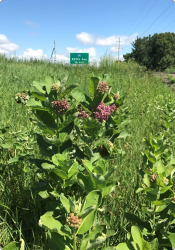
From the seat of a car, a roadside ditch may look like nothing more than a blur of weeds. But to a monarch butterfly, it is an oasis of nectar and milkweed needed for survival.
The loss of suitable habitat has been one of the biggest factors in the decline of the monarch population over the last several decades. However, milkweed and nectar plants, which monarchs depend on, thrive in disturbed habitat such as roadsides. Roadside rights-of-way contain everything monarchs need to survive and cover millions of acres of ground—providing an important piece in the puzzle of monarch conservation.
The Monarch Joint Venture has developed tools for transportation managers who want to enhance or maintain monarch habitat in roadside corridors. These include a GIS Landscape Prioritization Model and best management practices, and communication materials.

- GIS Landscape Prioritization Model – Identifies roadsides with the greatest potential for high-quality monarch habitat development.
- Monarch Roadside Habitat Evaluation Tool – Pairs a Rapid Assessment protocol for assessing current monarch habitat conditions along roadsides with a Habitat Calculator that computes monarch habitat quality scores for use in adaptive management.
- Best management recommendations and communications materials – For decision support.
Monarch Joint Venture developed these tools in partnership with the University of Minnesota, Oklahoma State University, Environmental Incentives, and the Xerces Society, with critical input from various road program managers. This project builds on the leadership shown by many transportation departments in providing pollinator habitat and developing pollinator-friendly management practices.
The Roadside Habitat for Monarchs project was supported by funding from the National Cooperative Highway Research Program (Project 20-119).







